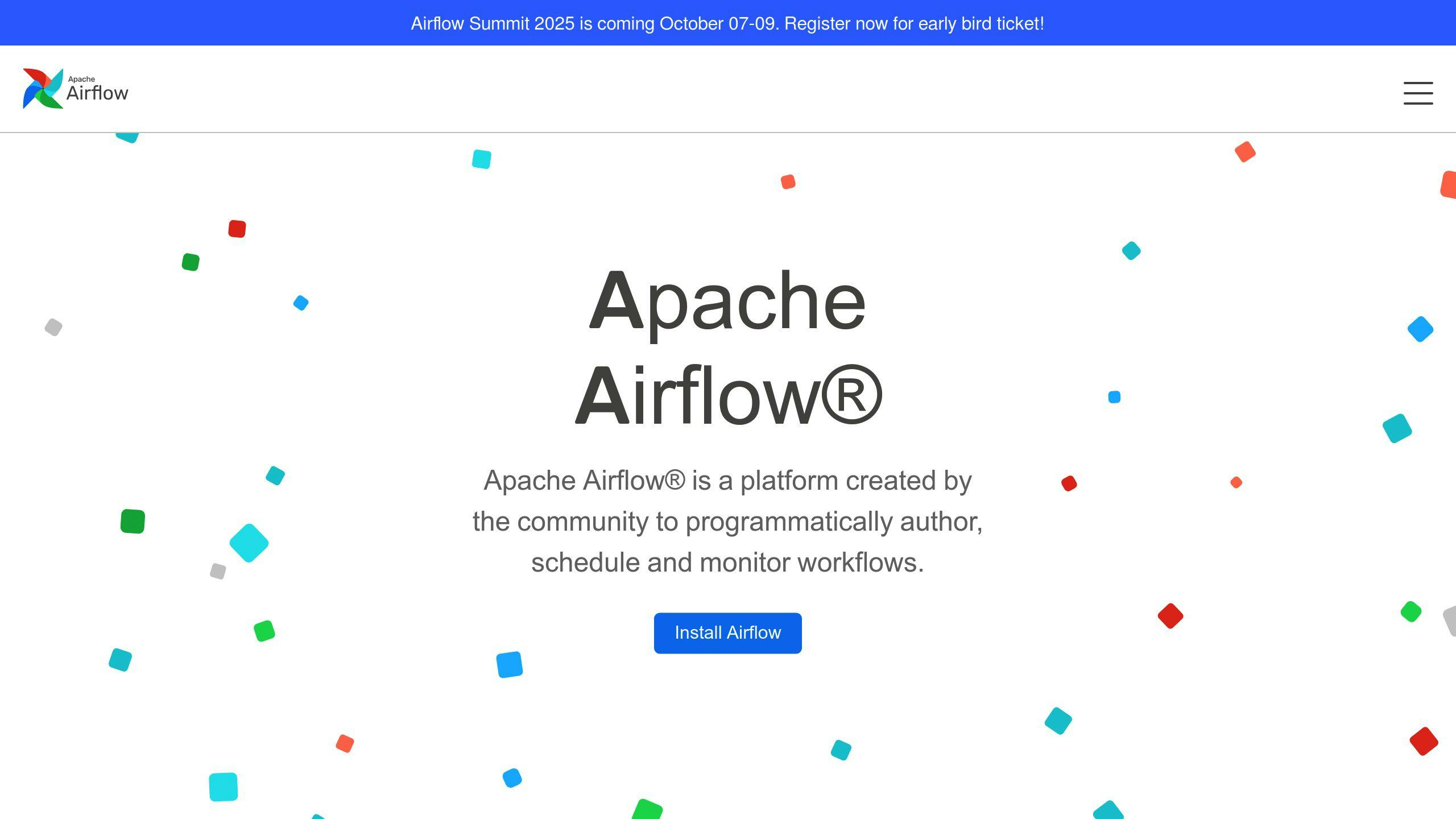A data pipeline is like an assembly line for your web scraping process. It ensures data is extracted, cleaned, and stored efficiently. Here’s what you’ll need:
- Key Stages: Extraction (tools like Scrapy), Transformation (clean/format data), Storage (databases like PostgreSQL), and Automation (managers like Apache Airflow).
- Why Pipelines Matter: They improve accuracy, reduce errors, scale easily, and save time with automation.
- Tools to Use: Scrapy, Beautiful Soup, Selenium, AWS RDS, and Apache Airflow.
- Best Practices: Respect site rules, use proxies, clean data with Pandas, and secure storage with encryption.
Quick Comparison of Tools for Web Scraping
| Tool | Best Use Case | Key Feature |
|---|---|---|
| Scrapy | Large-scale scraping | Built-in concurrency |
| Beautiful Soup | Static websites | Lightweight HTML parsing |
| Selenium | Dynamic content | Automates browser actions |
| Puppeteer | Headless scraping | Fast execution, JS handling |
This guide walks you through setting goals, choosing tools, and optimizing performance for scalable, automated web scraping pipelines.
Building Scraping Pipelines With Apache Airflow

How to Plan Your Pipeline
Here’s how you can design a pipeline that fits your project’s needs and scales effectively.
Set Goals and Data Needs
Start by defining SMART goals (Specific, Measurable, Achievable, Relevant, Time-bound) for your web scraping project. This helps clarify what you need from your pipeline.
| Goal Component | Example |
|---|---|
| Data Types | Product details (prices, reviews) |
| Update Frequency | Hourly or daily updates |
| Volume Expectations | Pages/records per scrape |
| Quality Requirements | Data accuracy and format |
"This guide is ideal for those seeking cost-effective, streamlined web scraping solutions." - Khoa Le
Pick Your Tools
Selecting the right tools is crucial. Whether you prefer coding frameworks or no-code solutions, here are some options to consider:
| Tool Type | Recommended Option | Best For |
|---|---|---|
| Framework | Scrapy | Large-scale projects, rated 4.8/5 |
| No-Code Solution | InstantAPI.ai | Quick setup, $9/month unlimited scrapes |
| Proxy Service | Bright Data | Advanced scraping, 99.99% uptime |
For example, InstantAPI.ai offers AI-powered, no-code scraping with features like automatic updates and JavaScript rendering.
Plan for Growth
Storage Planning:
- Use AWS RDS with data partitioning to ensure scalable storage.
- Implement effective indexing strategies for better performance.
Performance Optimization:
- Utilize server-side scraping, enable concurrent requests with throttling, and add caching to improve efficiency.
A scalable pipeline might include:
- A Python application for task scheduling.
- AWS RDS for reliable data storage.
- Apache Superset for data visualization.
- Docker containers for flexible deployment.
Data Collection Methods
Choose the Right Tools
Building a reliable data pipeline starts with picking the right tools for your project and the complexity of the websites you're targeting.
| Tool Type | Best Use Case | Key Features |
|---|---|---|
| Beautiful Soup | Static websites | Parses HTML/XML, lightweight |
| Selenium | Dynamic content | Handles JavaScript, automates tasks |
| Puppeteer | Performance needs | Uses Headless Chrome, fast execution |
| APIs | Direct endpoints | Reliable, direct data access |
"The key to successful web scraping is matching your tools to the complexity of your target website", says Anthony Ziebell, founder of InstantAPI.ai. "Our AI-powered approach has achieved 99.9% accuracy in data extraction while reducing setup time by 85%."
These tools are the backbone of your pipeline, directly influencing the data's quality and reliability.
Handling Dynamic Websites
Dynamic websites, often powered by JavaScript, require extra care. Here’s how you can tackle them effectively:
- Browser Automation: Tools like Puppeteer or Selenium can handle JavaScript content, logins, and interactive elements programmatically.
- Optimize Resources: Manage browser instances smartly, block unnecessary resources during scraping, and limit concurrent connections to avoid overloading servers.
Mastering these techniques ensures you can extract data efficiently without compromising performance.
Stay Compliant with Scraping Rules
Adhering to ethical and legal guidelines is non-negotiable. Here are some best practices:
| Practice | How to Implement |
|---|---|
| Rate Management | Use request limits and rotate proxies to avoid detection |
| Site Compliance | Respect robots.txt and Terms of Service |
| Resource Impact | Monitor server load and adjust scraping behavior |
For larger-scale operations, consider using dedicated proxy services. These often come with built-in features like rotation and rate limiting, ensuring smooth, uninterrupted data collection.
sbb-itb-f2fbbd7
Data Processing and Storage
Clean and Format Data
Python libraries such as Pandas are excellent for handling tasks like cleaning up missing values, removing duplicates, and fixing format inconsistencies in web-scraped data. For larger datasets, tools like Apache Spark can speed up these processes with distributed computing.
"Automated data validation during the scraping process can reduce cleaning time by up to 85% while maintaining data integrity." - Anthony Ziebell, InstantAPI.ai
After your data is cleaned and standardized, the next step is selecting a storage solution that fits the scale and needs of your project.
Pick a Storage System
The right storage system depends on your data's size and how you'll access it. For structured data, MySQL is a reliable choice. If you're working with raw, unstructured data, Amazon S3 offers scalable storage. For projects involving high-volume writes, Apache Cassandra is a solid option. These tools ensure your system can grow with your data without losing efficiency.
"When dealing with multi-language data sets, paying special attention to database collation and charset settings is crucial for maintaining data integrity", advises the PromptCloud Team.
Once you've chosen a storage solution, it's equally important to focus on securing your data.
Protect Your Data
When handling sensitive information, security is non-negotiable. Use encryption to protect data both during transfer (SSL/TLS) and at rest. Implement role-based access control (RBAC) to limit access and conduct regular audits to stay compliant with regulations. Tools like Prometheus and Grafana can help you monitor your pipeline's performance and spot potential security issues.
"To scrape the personal data of EU residents you now need to demonstrate that you have the explicit consent of the individual before scraping their personal data." - Sanaea Daruwalla, Head of Legal at Scrapinghub
Pipeline Automation
Schedule Tasks
Apache Airflow's DAG-based system simplifies the scheduling of even the most complex web scraping tasks.
"Scheduled scraping and task orchestration can boost efficiency by 40% and reduce server load." - Anthony Ziebell, InstantAPI.ai
You can schedule tasks during off-peak hours to minimize server strain, define task dependencies to maintain order, and set up automatic retries to ensure reliability. Tools like Scrapy and Puppeteer integrate well into automated scraping pipelines, making the process seamless.
Once your tasks are scheduled, it's important to monitor their performance to ensure everything runs smoothly and aligns with your project's objectives.
Monitor Performance
Effective monitoring requires a combination of logging and alerts. The ELK Stack (Elasticsearch, Logstash, and Kibana) is a powerful tool for tracking pipeline performance. It provides visibility into key metrics like response times, success rates, and resource usage. You can set thresholds to trigger alerts for issues like delays, errors, or high resource consumption.
Monitoring is only part of the equation - keeping operations optimized is just as crucial.
Speed Up Operations
To speed up your pipeline, focus on smarter resource management. Switching to asynchronous processing with Scrapy can increase throughput by up to 300% compared to traditional synchronous methods.
Other strategies include using Redis for caching, implementing parallel processing with Celery, and rotating proxies to avoid IP bans. For dynamic websites, tools like Puppeteer or Selenium can be configured for efficiency by disabling unnecessary browser features and using connection pooling.
"When we implemented parallel processing with proper rate limiting, our clients saw average processing times decrease from 45 minutes to just 12 minutes for large-scale scraping jobs", reports Anthony Ziebell.
Conclusion
Key Steps Review
Building a reliable web scraping pipeline requires careful planning and smooth integration of various components. This includes setting up tools for data collection, processing, and automation while using frameworks to manage workflows and monitor performance.
Regular Updates
Keeping your pipeline up-to-date is essential as websites and data requirements change over time. Tools like Git can help track modifications and manage updates effectively. Regular updates not only ensure compliance with changing website structures but also help maintain the quality and reliability of your data.
Here are the main areas to focus on for maintenance:
| Maintenance Area | Update Frequency | Key Focus Points |
|---|---|---|
| Data Quality | Weekly | Validation checks, error rates, accuracy metrics |
| Performance | Monthly | Response times, resource usage, success rates |
| Infrastructure | Quarterly | Tool updates, security patches, scaling needs |
By staying on top of these updates, your pipeline can remain efficient and continue to meet your data needs.
Tools List
Below is a selection of tools tailored for each stage of the pipeline:
Data Collection:
- Scrapy: An open-source framework ideal for large-scale scraping tasks.
- Puppeteer: A tool for headless browser automation.
- Bright Data: A robust enterprise solution for proxies and scraping.
Processing and Storage:
- Pandas: For data transformation and cleaning.
- MySQL/PostgreSQL: Reliable options for structured data storage.
- Redis: Useful for caching and managing queues.
Automation and Monitoring:
- Apache Airflow: For orchestrating workflows.
- ELK Stack: A powerful suite for monitoring and logging.
- Celery: Handles distributed task processing efficiently.
FAQs
Here are answers to common questions about automating web scraping pipelines, offering practical tips for both beginners and experts.
How can you automate web scraping with a simple data pipeline?
Automating a web scraping pipeline doesn't have to be complicated. The right tools can make the process much smoother:
| Tool | Primary Use | Key Advantage |
|---|---|---|
| Python + Scrapy | Large-scale scraping | Built-in concurrency |
| NodeJS | API integration | Strong async handling |
Python's Scrapy framework is a great choice for beginners. It allows you to set up spiders for extracting data with minimal effort and offers built-in concurrency for efficient scraping.
To automate tasks, you can use Python's schedule library or GitHub Actions to run periodic scraping jobs. For more advanced needs, AI-powered tools like InstantAPI.ai can handle changes in website structures, ensuring your scrapers stay up-to-date.


